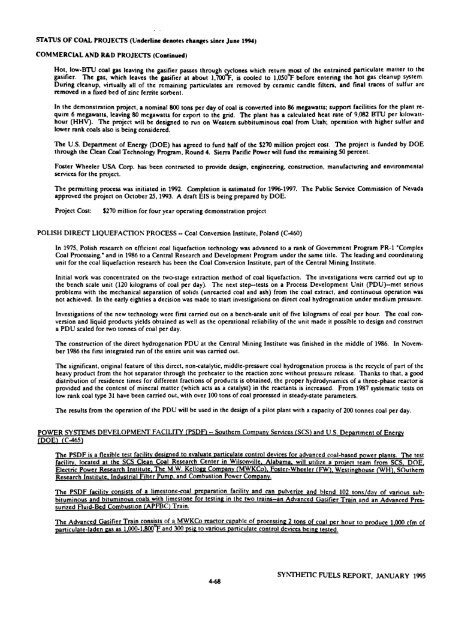Ikelic - Alliance Digital Repository
Ikelic - Alliance Digital Repository
Ikelic - Alliance Digital Repository
Create successful ePaper yourself
Turn your PDF publications into a flip-book with our unique Google optimized e-Paper software.
STATUS OF COAL PROJECTS (Underline denotes changes since June 1994)<br />
COMMERCIAL AND R&D PROJECTS (Continued)<br />
Hot, low-BTU coal gas leaving the gasifier passes through cyclones which return most of the entrained particulate matter to the<br />
gasifier. The gas, which leaves the gasifier at about 1.700T, is cooled to 1,050T^ before entering the hot gas cleanup system<br />
During cleanup, virtually all of the remaining particulates are removed by ceramic candle filters, and final traces of sulfur are<br />
removed in a fixed bed of zinc ferrite sorbent.<br />
In the demonstration project, a nominal 800 tons per day of coal is converted into 86 megawatts; support facilities for the plant re<br />
quire 6 megawatts, leaving 80 megawatts for export to the grid. The plant has a calculated heat rate of 9,082 BTU per kilowatthour<br />
(HHV). The project will be designed to run on Western subbituminous coal from Utah; operation with higher sulfur and<br />
lower rank coals also is being considered.<br />
The U.S. Department of Energy (DOE) has agreed to fund half of the $270 million project cost. The project is funded by DOE<br />
through the Clean Coal Technology Program, Round 4. Sierra Pacific Power will fund the remaining 50 percent.<br />
Foster Wheeler USA Corp. has been contracted to provide design, engineering, construction, manufacturing and environmental<br />
services for the project.<br />
The permitting process was initiated in 1992. Completion is estimated for 1996-1997. The Public Service Commission of Nevada<br />
approved the project on October 25, 1993. A draft EIS is being prepared by DOE.<br />
Project Cost: $270 million for four year operating demonstration project<br />
- POLISH DIRECT LIQUEFACTION PROCESS Coal<br />
Conversion Institute, Poland (C^*60)<br />
In 1975, Polish research on efficient coal liquefaction technology was advanced to a rank of Government Program PR-1 "Complex<br />
Coal Processing,"<br />
and in 1986 to a Central Research and Development Program under the same title. The leading and coordinating<br />
unit for the coal liquefaction research has been the Coal Conversion Institute, part of the Central Mining Institute.<br />
Initial work was concentrated on the two-stage extraction method of coal liquefaction. The investigations were carried out up to<br />
the bench scale unit (120 kilograms of coal per day). The next steptests on a Process Development Unit (PDU)-met serious<br />
problems with the mechanical separation of solids (unreacted coal and ash) from the coal extract, and continuous operation was<br />
not achieved. In the early eighties a decision was made to start investigations on direct coal hydrogenation under medium pressure.<br />
Investigations of the new technology were first carried out on a bench-scale unit of five kilograms of coal per hour. The coal con<br />
version and liquid products yields obtained as well as the operational reliability of the unit made it possible to design and construct<br />
a PDU scaled for two tonnes of coal per day.<br />
The construction of the direct hydrogenation PDU at the Central Mining Institute was finished in the middle of 1986. In Novem<br />
ber 1986 the first integrated run of the entire unit was carried out.<br />
The significant, original feature of this direct, non-catalytic, middle-pressure coal hydrogenation process is the recycle of part of the<br />
product heavy from the hot separator through the preheater to the reaction zone without pressure release. Thanks to that, a good<br />
distribution of residence times for different fractions of products is obtained, the proper hydrodynamics of a three-phase reactor is<br />
provided and the content of mineral matter (which acts as a catalyst) in the reactants is increased. From 1987 systematic tests on<br />
low rank coal type 31 have been carried out, with over 100 tons of coal processed in steady-state parameters.<br />
The results from the operation of the PDU will be used in the design of a pilot plant with a capacity of 200 tonnes coal per day.<br />
- POWER SYSTEMS DEVELOPMENT FACILITY (PSDF) Southern<br />
(DOE) (C^65)<br />
Company Services (SCS) and U.S. Department of Energy<br />
The PSDF is a flexible test facility designed to evaluate particulate control devices for advanced coal-based power plants. The test<br />
facility, located at the SCS Clean Coal Research Center in Wilsonville. Alabama, will utilize a project team from SCS. DOE.<br />
Electric Power Research Institute. The MW. Kellogg Company (MWKCo). Foster-Wheeler (FW). Westinghouse (WH). SOuthern<br />
Research Institute. Industrial Filter Pump, and Combustion Power Company.<br />
The PSDF facility consists of a limestone-coal preparation facility and can pulverize and blend 102 tons/day of various sub<br />
bituminous and bituminous coals with limestone for testing in the two trains-an Advanced Gasifier Train and an Advanced Pres<br />
surized Fluid-Bed Combustion (APFBC) Train.<br />
The Advanced Gasifier Train consists of a MWKCo reactor capable of processing 2 tons of coal per hour to produce 1.000 cfm of<br />
particulate-laden gas as 1.000-1.800F and 300 psig to various particulate control devices being tested.<br />
4-68<br />
~ ~<br />
SYNTHETIC FUELS REPORT, JANUARY 1995















![pace SrntfletIc fne]its report - Alliance Digital Repository](https://img.yumpu.com/10493335/1/190x245/pace-srntfletic-fneits-report-alliance-digital-repository.jpg?quality=85)
